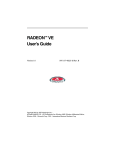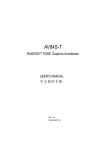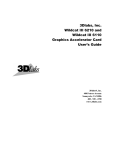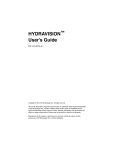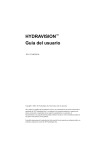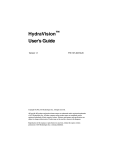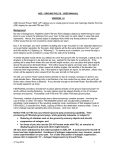Download ATI Technologies RADEON 7500 User`s guide
Transcript
RADEON™ 8500/ RADEON 7500™ User’s Guide Version 1.0 P/N 137-40282-10 Product Notice MACROVISION PRODUCT NOTICE A. B. Apparatus Claims of U.S. Patent Nos. 4,631,603, 4,577,216, 4,819,098, and 4,907,093 licensed for limited viewing users only. In the printed collateral material that accompanies the Product, the following notice must be printed in an appropriate place in such materials: This product incorporates copyright protection technology that is protected by method claims of certain U.S. patents and other intellectual property rights owned by Macrovision Corporation and other rights owners. Use of this copyright protection technology must be authorized by Macrovision Corporation, and is intended for home and other limited viewing uses unless otherwise authorized by Macrovision Corporation. Reverse engineering or disassembly is prohibited. Copyright 2001 by ATI Technologies Inc.: ATI and RADEON 8500/RADEON 7500 - ATI Technologies Inc.;Windows 98SE, Windows Millennium Edition, Windows NT4.0, Windows 2000 – Microsoft Corp.; VGA – International Business Machines Corp. 2 RADEON™ 8500/ RADEON 7500™ User’s Guide Documentation Updates ATI is constantly improving its product and the associated documentation. To maximize the value of your ATI product you should ensure that you have the most up-to-date documentation. ATI’s documentation contains helpful installation/configuration tips and other valuable product feature information. To access the latest documentation for your product visit http://www.ati.com/online/docupdate. RADEON™ 8500/ RADEON 7500™ User’s Guide 3 Multiple Monitors Your RADEON 8500/RADEON 7500 provides dual display functionality and TV Out from a single video card. This new technology changes the way you view your PC, TV, and video graphics. The RADEON 8500/RADEON 7500 uses HydraVision™ software to create a seamless multiple display desktop. Multiple monitor display works as one large work area. A single application can span all monitors, or many applications can occupy their own specific monitor. This feature will take your PC’s graphics and video capabilities to the next level. Connecting your RADEON 8500/RADEON 7500 to your monitors The RADEON 8500/RADEON 7500 provides support for one DVI-I monitor or two VGA monitors using the supplied DVI-Ito-VGA adapter. A television can also be used to expand your desktop by using the S-Video connector. Plug the monitor cable into your card (if you are running multiple monitors, connect their cables to the appropriate connectors), then turn on the computer and monitor(s). To connect a flat panel to the RADEON 8500/RADEON 7500 use the DVI-I connector as shown on the following page. To connect a VGA monitor to the DVI-I connector, plug the supplied DVI-I-to-VGA adapter into the DVI-I connector, then plug your monitor cable into the adapter. When you use multiple monitors with your RADEON 8500/RADEON 7500, one monitor will always be primary. Any additional monitor(s) will be designated as secondary. 4 RADEON™ 8500/ RADEON 7500™ User’s Guide TO TV/VCR DISPLAY CABLE TO VGA MONITOR TO DIGITAL/ANALOG DEVICE WITH DVI CONNECTOR DVI-I CONNECTOR ON CARD VGA CONNECTOR FROM MONITOR DVI-I-TO-VGA ADAPTER RADEON™ 8500/ RADEON 7500™ User’s Guide RADEON 8500/RADEON 7500 Display Configurations Display Configuration Connector(s) Used CRT monitor - 15-pin VGA connector - 24-pin DVI-I connector (with DVI-I-to-VGA adapter) DFP monitor - 24-pin DVI-I connector TV - s-video connector CRT monitor + TV - 15-pin VGA connector + s-video connector DFP monitor + TV - 24-pin DVI-I connector + s-video connector CRT monitor + DFP connector - 15-pin VGA connector + 24-pin DVI-I connector CRT monitor + CRT monitor - 15-pin VGA connector + 24-pin DVI-I connector (with DVI-I-to-VGA adapter) CRT monitor + DFP monitor + TV - 15-pin VGA connector + 24-pin DVI-I connector + s-video connector CRT monitor + CRT monitor + TV UNSUPPORTED CONFIGURATION Comments Unsupported configuration if the CRT monitor is attached to DVI-I connector via DVI-I-to-VGA adapter Please note that this will result in two independent displays with the third display “cloning” the image of one of the other two displays. Legend: CRT-(cathode ray tube) analog monitor utilizing the standard 15-pin VGA connector DFP-digital flat panel monitor utilizing the 24-pin DVI-I connector - The DVI-I connector can support a monitor using a 15-pin VGA connector via DVI-I-to-VGA adapter - The s-video connector on the board can support a composite connector via s-video-to-composite adapter 5 6 RADEON™ 8500/ RADEON 7500™ User’s Guide Multiple Monitor Controls The Windows® 2000 Multi-Monitor Dialog The Multiple Monitor control for Windows®NT4.0/ Windows® 2000 is found in the Displays tab of the Advanced Settings of the Display Properties. This dialog features a graphic representation of the current monitor array. You can enable and disable monitors by double-clicking on the monitor number in the list box. Multiple Monitor control for Windows®98SE and Windows® Me is located in the Settings tab of the Display Properties. From here, you can enable/disable multiple displays, change color depth and screen resolution. RADEON™ 8500/ RADEON 7500™ User’s Guide 7 To enable the secondary display (assuming a secondary display is attached to your RADEON 8500/RADEON 7500): 1 Right-click on monitor labeled “2”. 2 Click “Enable” in the drop-down menu. 3 Click “OK”. The Windows®98SE/Windows®Me Multi-Monitor Dialog To change resolution or color depth: 1 Left-click the desired monitor to make it active. 2 Make the desired changes to the color depth and resolution. To reposition your display, click and drag the appropriate monitor to the desired position. For example, the secondary display can be dragged to the left of the primary display. This allows you to position your secondary display to be either physically left or right of the primary display. 8 RADEON™ 8500/ RADEON 7500™ User’s Guide Note The RADEON 8500/RADEON 7500 offers Ratiometric expansion. Ratiometric expansion (or digital panel scaling as it is commonly known) expands a low resolution image to fill a higher resolution panel. However, Ratiometric expansion is only available on the primary display. Therefore, if a DFP is set as secondary, the extended desktop is disabled and the resolution is less than the DFP monitor’s native resolution. This causes the DFP monitor to default to center mode. RADEON™ 8500/ RADEON 7500™ User’s Guide Dynamic Monitor Reassignment Windows® 98SE/Windows®Me/Windows® NT4.0/Windows®2000 In addition to the fact that you never have to reboot when enabling and disabling multiple monitor settings, you can also change the assignment of your primary and secondary display on the fly without even rebooting! 1 Right-click on the Windows® desktop and click on Properties from the drop down menu. 2 Select the Settings tab. 3 Click on the Advanced button. 4 Select the Displays tab. This window shows you the display(s) that are active, and the button beside the active displays will be blue. The active blue buttons will have the word “Primary” or “Secondary” beside them. Clicking on a blue button (in a dual display configuration) will reassign the primary and secondary monitors. Clicking on “Apply” will enable any changes that you have made. 9 10 RADEON™ 8500/ RADEON 7500™ User’s Guide Note Video overlay allows for the viewing of full-motion video on your computer. However, there is only one video overlay, which is only available on the primary monitor. The RADEON 8500/RADEON 7500 allows you to change the primary monitor while viewing a DVD. Using HydraVision™ for Windows® 98SE/Windows®Me 11 Using HydraVision™ for Windows® 98SE/Windows®Me The Windows®98SE and Windows®Me operating systems are designed to recognize multiple monitors in a single system. HydraVision™ software is specifically designed for use with Windows®98SE and Windows®Me. HydraVision™ installation enables the Desktop Manager and creates a Windows® program group for HydraVision™ display management software. HydraVision™ and the Desktop Manager are activated whenever Windows® starts. Installing HydraVision™ adds menu options to the ATI Icon. Click on the ATI icon to access the application’s features and help, or to unload the HydraVision™ Desktop Manager. Accessing HydraVision™ Desktop Manager 12 Using HydraVision™ for Windows® 98SE/Windows®Me The HydraVision™ Desktop Manager allows you to modify your display options. You can access the Desktop Management and Hot Keys dialog boxes by clicking on the appropriate tab in the Desktop Manager. Along the bottom of each HydraVision™ dialog are four buttons: OK, Cancel, Apply and Help. OK implements the changes you’ve made in the HydraVision™ dialog and exits the Desktop Manager. Changes take effect immediately unless you see a message prompting you to restart your computer. Cancel discards all changes made to any section of the HydraVision™ dialog and closes the Desktop Manager. Apply implements your changes without closing the Desktop Manager. Help connects to local or online HTML-based help. You can also get context-sensitive on-screen help by moving your mouse over the relevant text for each control. Using HydraVision™ for Windows® 98SE/Windows®Me 13 Desktop Management Controls The Desktop Management Dialog The Desktop Management dialog lets you determine the behavior of pop-up windows and dialog boxes in a multiple monitor environment. Dialog control: Enable dialog repositioning—Toggles dialog control on and off. When it is checked, you can choose to have dialog boxes appear on the parent application’s monitor. (The parent application is the application that generated the dialog box.) If the parent application or associated monitor cannot be located, the dialog box defaults to monitor 1. You can also choose to have dialog boxes appear on the monitor in which the cursor is located or to always appear on a specific monitor in the array. 14 Using HydraVision™ for Windows® 98SE/Windows®Me Window control: Single monitor windows—When this box is checked, windows are sized no larger than a single monitor. Windows that are placed on monitor splits are automatically relocated to the monitor on which most of the window appears. HydraVision™ Max/Restore button management— Allows you to control the behavior of the Windows® Maximize button. When HydraVision™ is running, a HydraVision™ Max/Restore button appears in the upper right corner of your application title bars. Clicking this icon makes the active window maximize in one of two ways: − Max to window corners causes windows to maximize to the monitor(s) that contain the window’s upper left and lower right corners. − Max to full desktop causes windows to maximize to the entire monitor array. Max child windows—Keeps windows generated by parent applications from splitting across monitors. (A child window is a window residing within a parent application window.) The ability to keep child windows on a single monitor when maximized is extremely useful for editing multiple documents side by side in a parent application. NOTE: The HydraVision™ application title bar icon changes from a single square to two smaller squares when a window is in a HydraVision™ maximized state. Clicking the icon again restores the active window to its default state as a single square. General: Application position memory—Check this box to “remember” the size and location of application windows when they are closed and reapply those settings when the application is reopened. Automatically align monitors—Under Windows®98SE and Windows®Me, you can manually define monitor placement from the Settings dialog in the Display Properties dialog box. When this box is checked, HydraVision™ will override userdefined monitor placement if the monitors are not evenly aligned. Using HydraVision™ for Windows® 98SE/Windows®Me 15 NOTE: This control will work only if all monitors are running at the same resolution and your desktop is configured as a rectangle (monitors side-by-side). Remove HydraVision™ titlebar buttons—This box removes or restores the buttons placed on the title bar in installed applications. Remove MultiDesk system tray icon—This box removes or restores the MultiDesk system tray icon. MultiDesk Settings—This button gives access to all the MultiDesk Properties. Here you can enable, disable and name active desktops. Load/Unload Desktop Manager—This button restores or removes the HydraVision™ Desktop Manager tracking program. Unloading the Desktop Manager returns display settings to Windows®98SE and Windows®Me defaults. You should only select this option if you do not want to use any multiple monitor dialog box controls and window controls or hot keys. NOTE: MultiDesk will not reload automatically when Windows® restarts. You will need to reload MultiDesk from the Desktop Manager. Load/Unload MultiDesk—This button restores or removes multiple desktop functionality. NOTE: MultiDesk will not reload automatically when Windows® restarts. You will need to reload MultiDesk from the Desktop Manager dialog box. Individual Application Settings—This button allows you to specify, enable and disable desktop management settings for individual applications. You can access these settings by clicking on the down arrow of the HydraVision™ icon in the application title bar or by clicking the Individual Application Settings button in the Desktop Management dialog. NOTE: These settings override the global settings defined in the Desktop Management dialog. 16 Using HydraVision™ for Windows® 98SE/Windows®Me Hot Keys Controls The Hot Keys Dialog HydraVision™ allows you to specify hot key shortcuts for common operations such as starting applications, snapping applications to designated monitors, and changing display resolution. NOTE: Hot Keys only work if HydraVision™ is installed and loaded. Create/Remove Hot Keys To create custom hot key sequences, select a Modifier key (Shift, Alt, etc.), a Hot key, and the Hot key function you want this key combination to perform. Click Add to enter your new combination in the Assigned hot keys list box. Click Apply to activate assigned hot keys. NOTE: ATI recommends that a modifier key be used with any function key (F1, F2, etc.) assigned as a hot key. This will prevent interference with the function of these keys in individual applications. To delete a hot key from the Assigned hot keys list box, highlight it, click Remove, and then click Apply. Using HydraVision™ for Windows® 98SE/Windows®Me 17 You can also disable all hot keys listed in the Assigned hot keys list box by checking the Disable hot keys box near the bottom of the Hot Keys dialog. Using Hot Keys You can use any assigned hot key at any time, from within any application, to change your display. Provided hot key functions include: Snap App to Monitor HydraVision™ Pop-up Menu Run Application Gather All Windows to Monitor 1 Find Cursor Next Desktop Zoom Display In/Out Zoom In/Out on Monitor Allows you to move or “snap” active windows or dialogs from monitor to monitor for quick placement and viewing of desktop contents. Allows on-the-fly access to HydraVision™ controls. Lets you start any application with a hot key. Allows you to find applications that are hidden or are open and lost on disabled monitors. Locates the cursor on a busy or crowded desktop Accesses other active desktops Causes the desktop resolution to increase or decrease. Causes the resolution of the active monitor to increase or decrease. 18 Using HydraVision™ for Windows® 98SE/Windows®Me MultiDesk HydraVision™ software supports multiple desktops. With MultiDesk, one active desktop will always be visible, while up to eight active desktops can reside in the background. When MultiDesk is running, the MultiDesk icon in the system tray displays the number assigned to the current desktop. NOTE: MultiDesk is installed with HydraVision™. However, multiple desktop support and HydraVision™ can be loaded/unloaded and operated independently of each other. HydraVision™ MultiDesk Icon MultiDesk System Tray Icon Right-click on this icon to access MultiDesk controls. In addition to accessing active desktops from the system tray, you can also access active desktops with a Hot key shortcut. NOTE: Hot Keys only work if HydraVision™ is installed and loaded. MultiDesk Pop-Up Menu Using HydraVision™ for Windows® 98SE/Windows®Me 19 To switch to another defined desktop, select the appropriate desktop number from the pop-up menu. To enable, disable and name active desktops, select MultiDesk Properties from the pop-up menu. To arrange applications within active desktops, or to enable specific applications on all desktops, select Arrange MultiDesk from the pop-up menu. MultiDesk Properties allows you to control the desktops. Right-click a Desktop tab to set it Active, Inactive, or Disabled. Inactive desktops MAY contain applications; however, they are temporarily disabled. Disabled desktops cannot contain any applications. If an Active or Inactive desktop that contain applications is disabled, the application will be automatically moved to an Active desktop. You can also give a desktop a unique name. Double-click the desired desktop tab. The tab will turn grey and a blinking cursor will appear. Simply type in the new name. When you have renamed the desktop click on the tab to save the change. Keep on all desks allows you to have a selected application visible on all desktops. The MultiDesk functionality can be removed by selecting Unload HydraVision™ MultiDesk from the pop-up menu of the ATI Icon or the Desktop Manager. NOTE: MultiDesk will not reload automatically when Windows® restarts. You will need to reload MultiDesk from the Desktop Manager. 20 Using HydraVision™ for Windows® 98SE/Windows®Me Using HydraVision™ for Windows® NT4.0/Windows® 2000 21 Using HydraVision™ for Windows® NT4.0/Windows® 2000 HydraVision™ software is specifically designed for use with Windows®NT4.0 and Windows®2000. HydraVision™ installation enables the Desktop Manager and creates a Windows® program group for HydraVision™ display management software. HydraVision™ and the Desktop Manager are activated whenever Windows® starts. Installing HydraVision™ adds menu options to the ATI Icon. Click on the ATI icon to access the application’s features and help, or to unload the HydraVision™ Desktop Manager. Accessing HydraVision™ Desktop Manager 22 Using HydraVision™ for Windows® NT4.0/Windows® 2000 The HydraVision™ Desktop Manager allows you to modify your display options. You can access the Desktop Management and Hot Keys dialog boxes by clicking on the appropriate tab in the Desktop Manager. Along the bottom of each HydraVision™ dialog are four buttons: OK, Cancel, Apply and Help. OK implements the changes you’ve made in the HydraVision™ dialog and exits the Desktop Manager. Changes take effect immediately unless you see a message prompting you to restart your computer. Cancel discards all changes made to any section of the HydraVision™ dialog and closes the Desktop Manager. Apply implements your changes without closing the Desktop Manager. Help connects to local or online HTML-based help. You can also get context-sensitive on-screen help by moving your mouse over the relevant text for each control. Using HydraVision™ for Windows® NT4.0/Windows® 2000 Desktop Management Controls The Desktop Management Dialog Windows NT4.0 The Desktop Management Dialog Windows 2000 23 24 Using HydraVision™ for Windows® NT4.0/Windows® 2000 The Desktop Management dialog lets you determine the behavior of pop-up windows and dialog boxes in a multiple monitor environment. Dialog control: Enable dialog repositioning—Toggles dialog control on and off. When it is checked, you can choose to have dialog boxes appear on the parent application’s monitor. (The parent application is the application that generated the dialog box.) If the parent application or associated monitor cannot be located, the dialog box defaults to monitor 1. You can also choose to have dialog boxes appear on the monitor in which the cursor is located or to always appear on a specific monitor in the array. Window control: Single monitor windows—When this box is checked, windows are sized no larger than a single monitor. Windows that are placed on monitor splits are automatically relocated to the monitor on which most of the window appears. HydraVision™ Max button management—Allows you to control the behavior of the Windows® Maximize button. When HydraVision™ is running, a HydraVision™ Max/Restore button appears in the upper right corner of your application title bars. Clicking this icon makes the active window maximize in one of three ways: 1. Max to window corners causes windows to maximize to the monitor(s) that contain the window’s upper left and lower right corners. 2. Max to full desktop causes windows to maximize to the entire monitor array. 3. Max to current monitor causes windows to maximize to the current monitor. Max child windows—Keeps windows generated by parent applications from splitting across monitors (A child window is a window residing within a parent application window.) The ability to keep child windows on a single monitor when maximized is extremely useful for editing multiple documents side by side in a parent application. Using HydraVision™ for Windows® NT4.0/Windows® 2000 25 NOTE: The HydraVision™ application title bar icon changes from a single square to two smaller squares when a window is in a HydraVision™ maximized state. Clicking the icon again restores the active window to its default state as a single square. General: Application position memory—Check this box to “remember” the size and location of application windows when they are closed and reapply those settings when the application is reopened. Boot to single monitor—Check this box to enable a single monitor only when the computer starts. All other connected devices will be disabled. NOTE: Extended Desktop must be enabled before the computer is restarted. Remove HydraVision™ title bar buttons—This box removes or restores the ATI buttons placed on the title bar in installed applications. Remove MultiDesk system tray icon—This box removes or restores the MultiDesk system tray icon. MultiDesk Settings—This button gives access to all the MultiDesk Properties. Here you enable, disable and name active desktops. Load/Unload Desktop Manager—This button restores or removes the HydraVision™ Desktop Manager tracking program. You should only select this option if you do not want to use any multiple monitor dialog box controls and window controls or hot keys. . NOTE: MultiDesk will not reload automatically when Windows® restarts. You will need to reload MultiDesk from the Desktop Manager dialog box. 26 Using HydraVision™ for Windows® NT4.0/Windows® 2000 Load/Unload MultiDesk—This button restores or removes multiple desktop functionality. NOTE: MultiDesk will not reload automatically when Windows® restarts. You will need to reload MultiDesk from the Desktop Manager dialog box. Individual Application Settings—This button allows you to specify, enable and disable desktop management settings for individual applications. You can access these settings by clicking on the down arrow of the HydraVision™ icon in the application title bar or by clicking the Individual Application Settings button in the Desktop Management dialog. NOTE: These settings override the global settings defined in the Desktop Management dialog. Using HydraVision™ for Windows® NT4.0/Windows® 2000 27 Hot Keys Controls The Hot Keys Dialog HydraVision™ allows you to specify hot key shortcuts for common operations such as starting applications, snapping applications to designated monitors, and changing display resolution. NOTE: Hot Keys only work if HydraVision™ is installed and loaded. Create/Remove Hot Keys To create custom hot key sequences, select a Modifier key (Shift, Alt, etc.), a Hot key, and the Hot key function you want this key combination to perform. Click Add to enter your new combination in the Assigned hot keys list box. Click Apply to activate assigned hot keys. NOTE: ATI recommends that a modifier key be used with any function key (F1, F2, etc.) assigned as a hot key. This will prevent interference with the function of these keys in individual applications. To delete a hot key from the Assigned hot keys list box, highlight it, click Remove, and then click Apply. 28 Using HydraVision™ for Windows® NT4.0/Windows® 2000 You can also disable all hot keys listed in the Assigned hot keys list box by checking the Disable hot keys box near the bottom of the Hot Keys dialog. Using Hot Keys You can use any assigned hot key at any time, from within any application, to change your display. Provided hot key functions include: Snap App to Monitor HydraVision™ Pop-up Menu Run Application Gather All Windows to Monitor 1 Find Cursor Next Desktop Zoom Display In/Out Zoom In/Out on Monitor Allows you to move or “snap” active windows or dialogs from monitor to monitor for quick placement and viewing of desktop contents. Allows on-the-fly access to HydraVision™ controls. Lets you start any application with a hot key. Allows you to find applications that are hidden or are open and lost on disabled monitors. Locates the cursor on a busy or crowded desktop Accesses other active desktops Causes the desktop resolution to increase or decrease. Causes the resolution of the active monitor to increase or decrease. Using HydraVision™ for Windows® NT4.0/Windows® 2000 29 MultiDesk HydraVision™ software supports multiple desktops. With MultiDesk, one active desktop will always be visible, while up to eight active desktops can reside in the background. When MultiDesk is running, the MultiDesk icon in the system tray displays the number assigned to the current desktop. NOTE: MultiDesk is installed with HydraVision™. However, multiple desktop support and HydraVision™ can be loaded/unloaded and operated independently of each other. HydraVision™ MultiDesk Icon MultiDesk System Tray Icon Right-click on this icon to access MultiDesk controls. In addition to accessing active desktops from the system tray, you can also access active desktops with a Hot key shortcut. NOTE: Hot Keys only work if HydraVision™ is installed and loaded. MultiDesk Pop-Up Menu 30 Using HydraVision™ for Windows® NT4.0/Windows® 2000 To switch to another defined desktop, select the appropriate desktop number from the pop-up menu. To enable, disable and name active desktops, select MultiDesk Properties from the pop-up menu. The MultiDesk functionality can be removed by selecting Unload HydraVision™ MultiDesk from the pop-up menu. MultiDesk Properties allows you to control the desktops. Rightclick a Desktop tab to set it Active, Inactive, or Disabled. Inactive desktops MAY contain applications; however, they are temporarily disabled. Disabled desktops cannot contain any applications. If an Active or Inactive desktop that contain applications is disabled, the applications will be automatically moved to an Active desktop. You can also give a desktop a unique name. Double-click the desired desktop tab. The tab will turn grey and the cursor will blink. Simply type in the new name. When you have finished renaming the desktop click on the tab to save the change. Keep on all desks allows you to have a selected application visible on all desktops. The MultiDesk functionality can be removed by selecting Unload ATI Icon or the Desktop Manager. NOTE: MultiDesk will not reload automatically when Windows® restarts. You will need to reload MultiDesk from the Desktop Manager. 31 OpenGL Display Properties The OpenGL properties page gives you complete control of the OpenGL settings. Optimization Preference Quality allows you to optimize your OpenGL settings for quality. Performance allows you to optimize your OpenGL settings for performance. 32 OpenGL Settings Convert 32 bit textures to 16 bit allows you to increase video performance for games that make heavy use of textures. However this could also reduce image quality. Enable KTX buffer region extension enables rapid updates of those portions of your screen that have been moved. Enable page flipping allows you to enable hardware acceleration of page flipping to swap full screen buffers. Force 16-bit Z-buffering allows you to disable all other formats of Z-buffer and utilizes 16-bit Z-buffering. Disable dithering when alpha blending may remove artifacts left on the screen when both dithering and alpha blending are enabled. Wait for vertical sync lowers the frames per second rate in full screen games. However this can reduce the image tearing that can occur with higher frame rates. Enable texture compression enables and disables texture compression. Full Screen anti-aliasing allows you to set the level of fullscreen anti-aliasing. This will result in an overall higher quality image with a slight reduction in performance. Anisotropic texture filtering allows you to set a level of anisotropic texture filtering. This will result in much higher quality textures with a negligible reduction in performance. Level of Detail allows you to set the level of mipmapped detail. The Sharp setting is recommended for larger, more detailed, mipmapping scenes. The Fuzzy setting is recommended for smaller, less detailed, mipmapping scenes. 33 Direct 3D Display Properties The Direct 3D properties page allows you to adjust the Direct 3D settings. D3D Settings Wait for vertical sync allows you to lower the frame rate of full screen games. This will reduce image tearing that can occur with higher frame rates. W-buffer support allows you to enable or disable W-buffer support. It is recommend that W-buffer support should be disabled for games that do not support this feature. Compressed texture format allows you to enable support for DirectX compressed texture formats. Some applications cannot handle too many texture formats. Disabling compressed texture format the video driver ceases to support this feature. This reduces the number of texture formats supported. 34 Alternate pixel center may eliminate problems with some 3D games that displays vertical and horizontal lines around textures or text that appears incorrect. However, this setting should only be used if you are experiencing these symptoms, as it may cause problems with other games. Z-buffer bit depths allows you to set the Z-buffer bit rate. By default 16:24 (16 and 24) is selected to achieve optimum performance. 8-bit Stencil allows you to add 32-bit Z-buffer with 8 bits for stencil and 24 bits for the Z-buffer. Anti-aliasing provides you with an overall higher quality video image with a slight reduction in performance. When “Application Preference” mode is selected, the video driver will use anti-aliasing only when an application requests it. When “Always On” mode is selected, the video driver will force antialiasing on all applications. 2 Samples provides a higher sample ratio, which improves overall image quality even further, with a slight reduction in performance. This also requires more video memory. 4 Sample provides a higher sample ratio, which improves overall image quality even further, with a slight reduction in performance. This also requires more video memory. Dithering method when alpha blending will remove certain onscreen artifacts that are sometimes produced when both dithering and alpha blending are enabled. Defaults restores your Direct 3D setting to their default values. 35 Color Properties The Color Properties is used to adjust the color settings. It also allows gamma control for video playing of the Video Overlay. The color settings affect all display devices mapped to the view. You can change red, green, and blue display colors. Set Desktop and Video Overlay brightness (gamma) levels can also be changed. Desktop brightness increases or decreases the color brightness of you desktop. The higher the gamma value, the higher the brightness and contrast of your display. Overlay brightness increases or decreases the color brightness of your video overlay window. The higher the gamma value, the higher the brightness and contrast of your display. Game gamma increases or decreases the color brightness of Direct 3D or OpenGL games played in fullscreen mode. Color Curve adjusts the selected color (red, green, or blue) by moving the color curve with your mouse. Default restores the color settings to the default values. 36 37 Using TV Out View your PC’s display on a TV! Your new RADEON 8500/RADEON 7500 card has TV Out capability. You can attach your card to a television and monitor at the same time. Or you can connect it to your VCR and record your monitor’s display. Television display is ideal for playing games, giving presentations, watching movies, and browsing the Internet. The following tips will help you get the most out of your TV Out feature. IMPORTANT INFORMATION for European Customers Some PC monitors in Europe cannot be used simultaneously with television display. When you enable television display in Europe, the refresh rate for the monitor and television is set to 50Hz. Some monitors may not support this refresh rate and could be damaged. • Please check the documentation supplied with your monitor to see if your monitor supports a refresh rate of 50Hz. If your monitor does not support 50 Hz (or if you are not sure), then turn off your monitor before turning on your computer when using your television as a display. For information on disabling television display, see Enabling and Disabling the Television Display on page 41. Some televisions in Europe may use an SCART connection. If you use SCART, please read Using SCART Connectors for European Televisions on page 40 before attempting to connect your PC to your television. 38 Connecting your RADEON 8500/RADEON 7500 to a TV or a VCR To connect your graphics card to a television or a VCR, use an S-Video cable from your RADEON 8500/RADEON 7500 to the television (or VCR). However, most televisions (and VCRs) have a Composite video input, in which case you can use the supplied S-Video to Composite video adapter. If your television has cable input only, which is the case on older units, you can connect your RADEON 8500/RADEON 7500 to your television through your VCR or an RF modulator (available in most electronics stores). Connecting Your R200/RV200 TV Out to a Television or VCR 1 Turn off your computer and your television (or VCR). 2 Ensure your graphics card is installed correctly. For information about placing the card in your computer and installing the enhanced ATI driver, see the RADEON 8500/RADEON 7500 Getting Started guide. 3 Determine if your television (or VCR) has an S-Video or Composite video connection. 4 Looking at the back of your computer, locate your RADEON 8500/RADEON 7500 card. Using an S-Video cable or the supplied adapter cable, attach one end of the cable to your graphics card and the other to your television (or VCR). See “Connecting your ATI RADEON 8500/RADEON 7500 card to a TV (or VCR)” on the following page. 39 Connecting your ATI RADEON 8500/RADEON 7500 card to a TV (or VCR) 5 Turn on your computer and your television (or VCR). 6 To turn your television display on and off, please see Enabling and Disabling the Television Display on page 41. 40 Using SCART Connectors for European Televisions (Right = Red) Audio In (Left = White) Connect to audio source Connect to TV or VCR Audio Cable Video Adapter Cable SCART Connector Composite Video In (Yellow) Connect to S-Video Out Figure 2. Using a SCART connector with the video adapter cable The SCART connector supports only the Composite video format, which means you will have to use the video adapter cable. The above illustration shows how to connect your RADEON 8500/RADEON 7500 to a European TV using the SCART. If your European television does support S-Video (S-VHS) input, you can use an S-Video cable (available in most consumer electronic stores) to view your PC on a television. 41 Using and Adjusting TV Out Enabling and Disabling the Television Display 1 Click Start. 2 Point to Settings, then click Control Panel. 3 Double-click Display. 4 Click on the Settings tab and then the Advanced... button. 5 Click on the ATI Displays tab. 6 Click on the green enable/disable button next to the word “TV” to enable/disable television display. If there is no display on your TV, you may need to switch it to video display mode. For more information, consult the documentation supplied with your TV. If your television is connected to your VCR, you may need to tune the TV to the VCR’s output. For information about connecting your TV to your VCR, consult the documentation that came with your VCR. 7 Click Apply to save the changes you have made. For information about how to use television display and the ATI Displays Properties page, click the Help button. Note A TV cannot be left connected to the graphics card if two analog monitors are connected to the RADEON 8500/RADEON 7500, even if the TV is off and not enabled in the software. An analog monitor connected to the DVI-I connector cannot be left connected to the RADEON 8500/RADEON 7500 when TV out is enabled. In both cases, the RADEON 8500/RADEON 7500 will become overloaded, resulting in a dim image on all devices. Starting Windows® with Television Display Enabled The television screen may become scrambled during the initial Windows® logo display. This is only a temporary effect and your television screen will be restored within a few seconds. 42 During start up, your RADEON 8500/RADEON 7500 will go through a sequence of mode settings, during which your television display will remain blank. This process takes only a few seconds and helps program the television display. Using a Monitor vs. Using the Television Display Using your television for your computer’s display is ideal for playing games, giving presentations, watching movies, and browsing the Internet. However, the display on your monitor may change or looked squashed. This occurs because the display adjusts to fit the dimensions of your television. To correct the monitor’s display, use the monitor’s control buttons to adjust its display size and position. Some single frequency monitors may not work with television display enabled. If you experience problems when television display is enabled, disable television display to restore your monitor’s display. Adjusting Monitor Display The size of the display on your monitor may be smaller and not perfectly centered when you have television display enabled. These effects are caused by the changes required to provide a proper display on the television. Use the controls available on the Adjustments tab on the Monitor Properties page (accessible by clicking on the Monitor button on the ATI Displays tab) to adjust the display on your monitor only. Click on the Television button to adjust the television display only. Viewing Text on Television A TV is designed primarily to show moving, rather than static, images. The large dot pitch of a TV (which is fine for moving video) will yield poor quality static images such as text. The small text sizes commonly used for computer desktops can appear blurred or unclear on a TV. You can compensate for this by using larger fonts. 43 To Use Larger Display Fonts 1 Click Start. 2 Point to Settings, then click Control Panel. 3 Double-click Display. 4 Click on the Settings tab and then the Advanced... button. 5 Make sure you’re on the General tab. 6 In the Font Size box, select the size you want your displayed fonts to be. 7 Click Apply, then follow the onscreen instructions to save your new settings. Reducing Edge Distortion When using a television for your PC’s display, you may see some edge distortion on the left and right side of your television screen. This effect depends on your television and the PC application you are running. To reduce edge distortion, you can increase the TV display’s horizontal size. To Increase the Horizontal Size 1 Click Start. 2 Point to Settings, then click Control Panel. 3 Double-click Display. 4 Click on the Settings tab and then the Advanced... button. 5 Click on the ATI Displays tab. 6 Click on the TV button. 7 Make sure you’re on the Adjustments tab. 8 Click on the plus (+) button under Horizontal Screen to increase the horizontal size of the television display. 9 Click Apply to save the changes you have made. You can also reduce edge distortion by reducing the TV’s brightness. 44 To Change the Brightness 1 Click Start. 2 Point to Settings, then click Control Panel. 3 Double-click Display. 4 Click on the Settings tab and then the Advanced... button. 5 Click on the ATI Displays tab. 6 Click on the TV button. 7 Drag the Brightness slider to the left to decrease the brightness. 8 Click Apply to save the changes you have made. Changing Display Configurations If you move your computer to a place where you are using television display only, make sure that you have the television display feature enabled; see Enabling and Disabling the Television Display on page 41. You can set your display resolution as high as 1024 x 768. However, higher resolutions will result in a virtual desktop. If a television is your only display device and a higher mode is selected, the display on your television will disappear. Using Games and Applications Some older games and applications may program your RADEON 8500/RADEON 7500 card directly to run under a specific display mode. This may cause your television display to turn off automatically or become scrambled (the PC monitor will not be affected). Your television display will be restored once you exit the game or if you restart your computer.













































